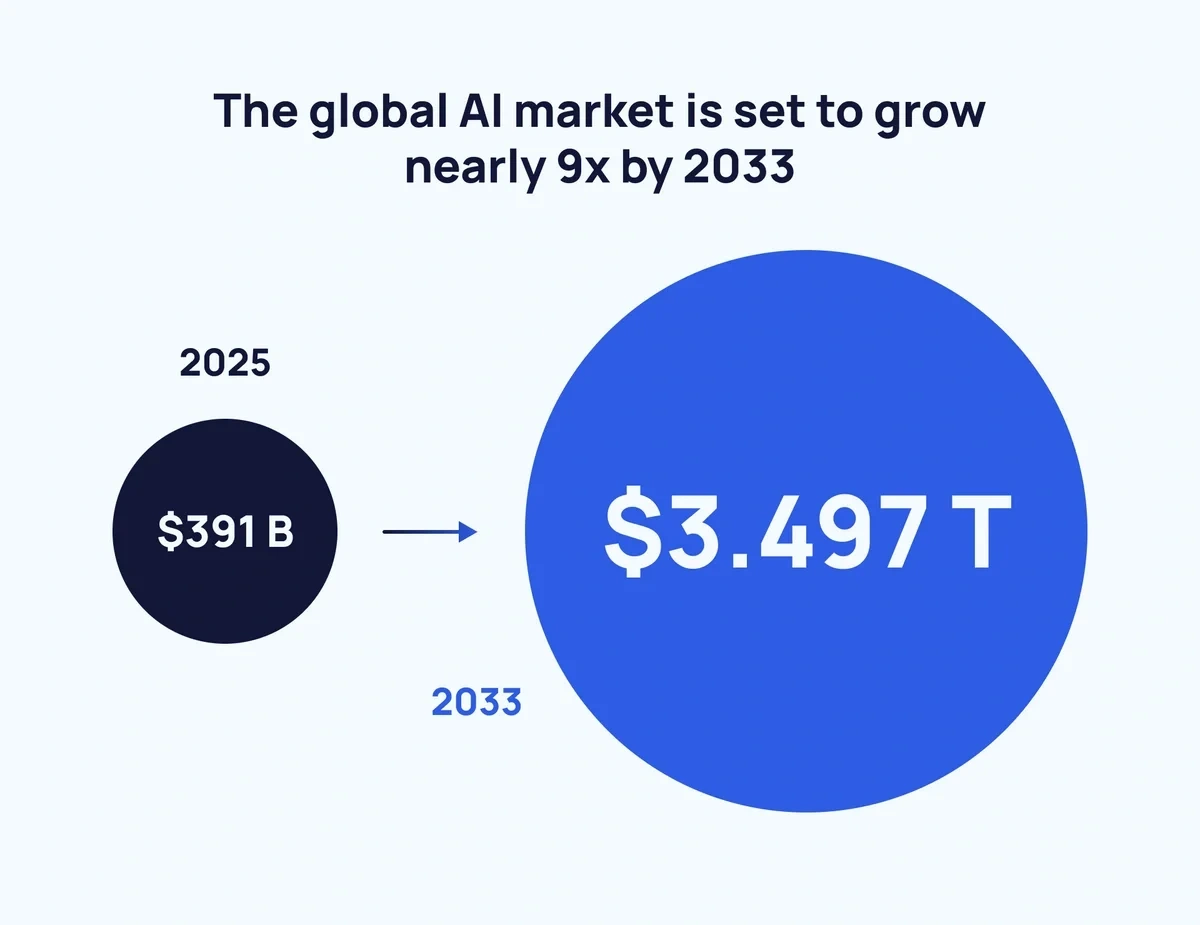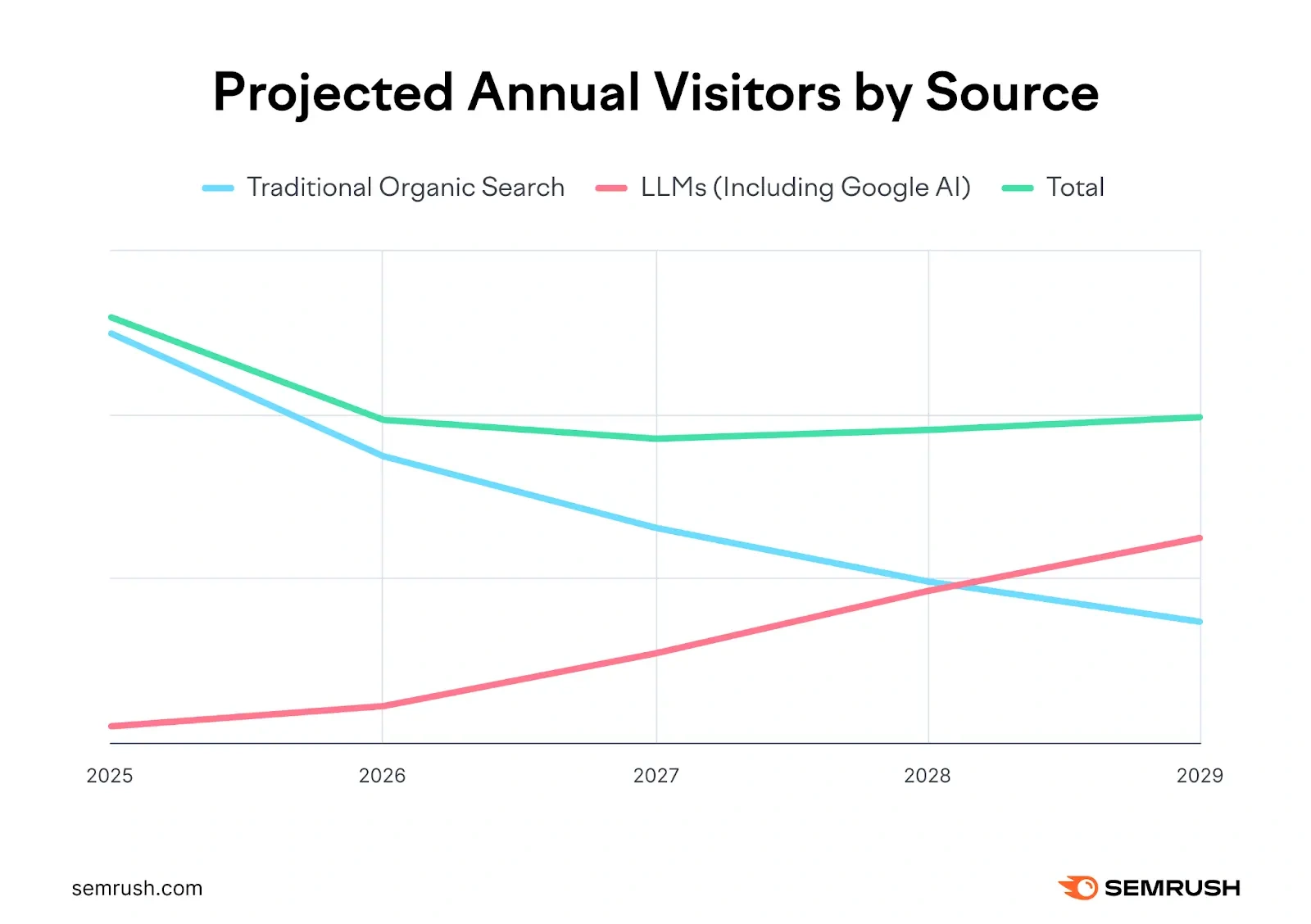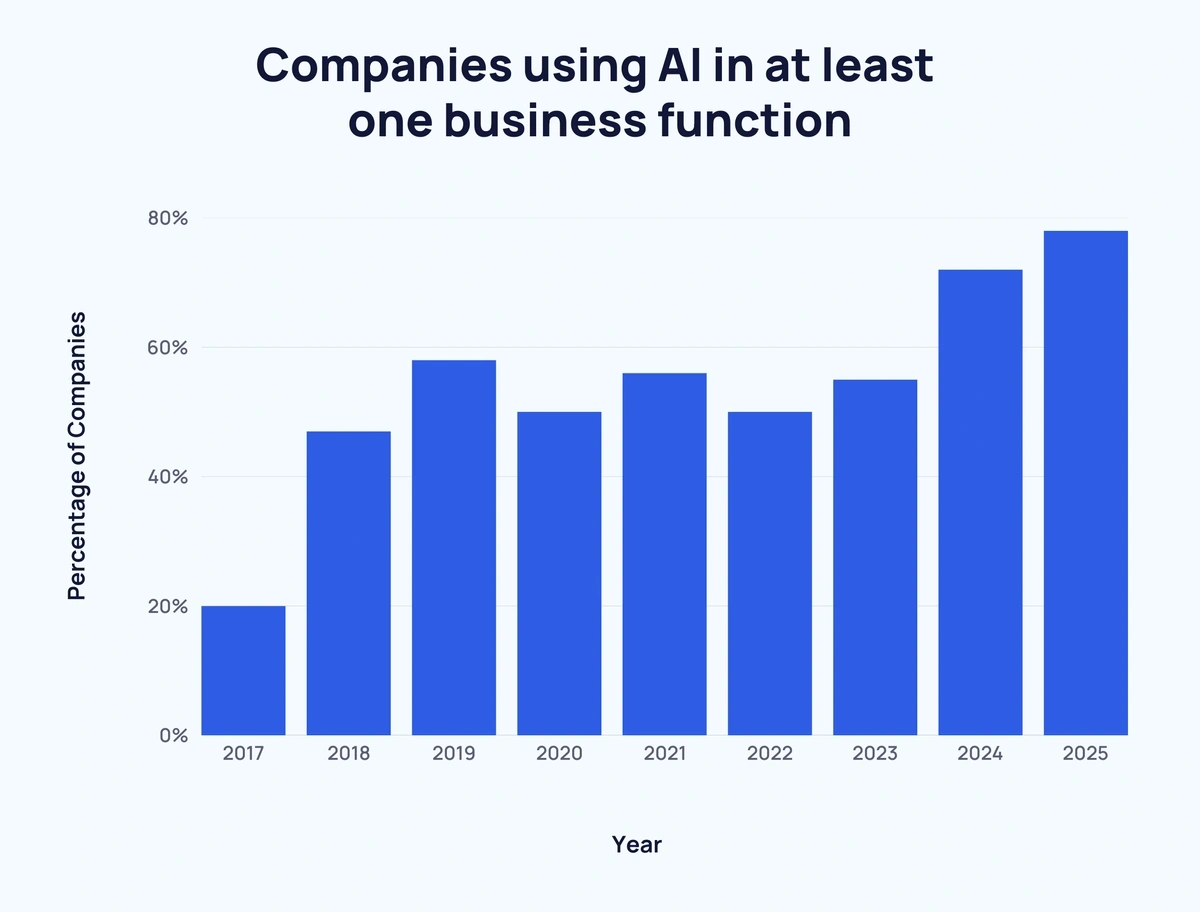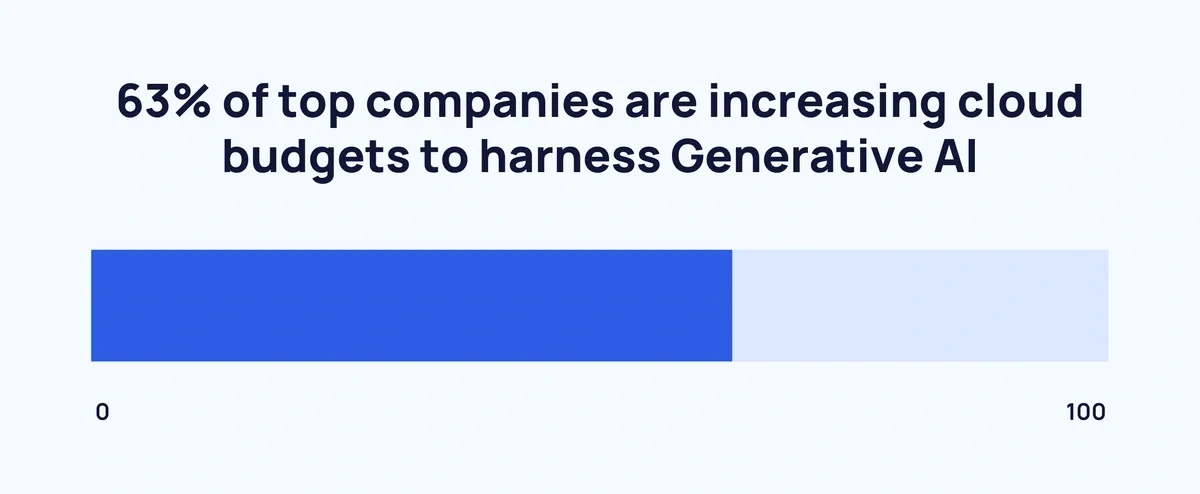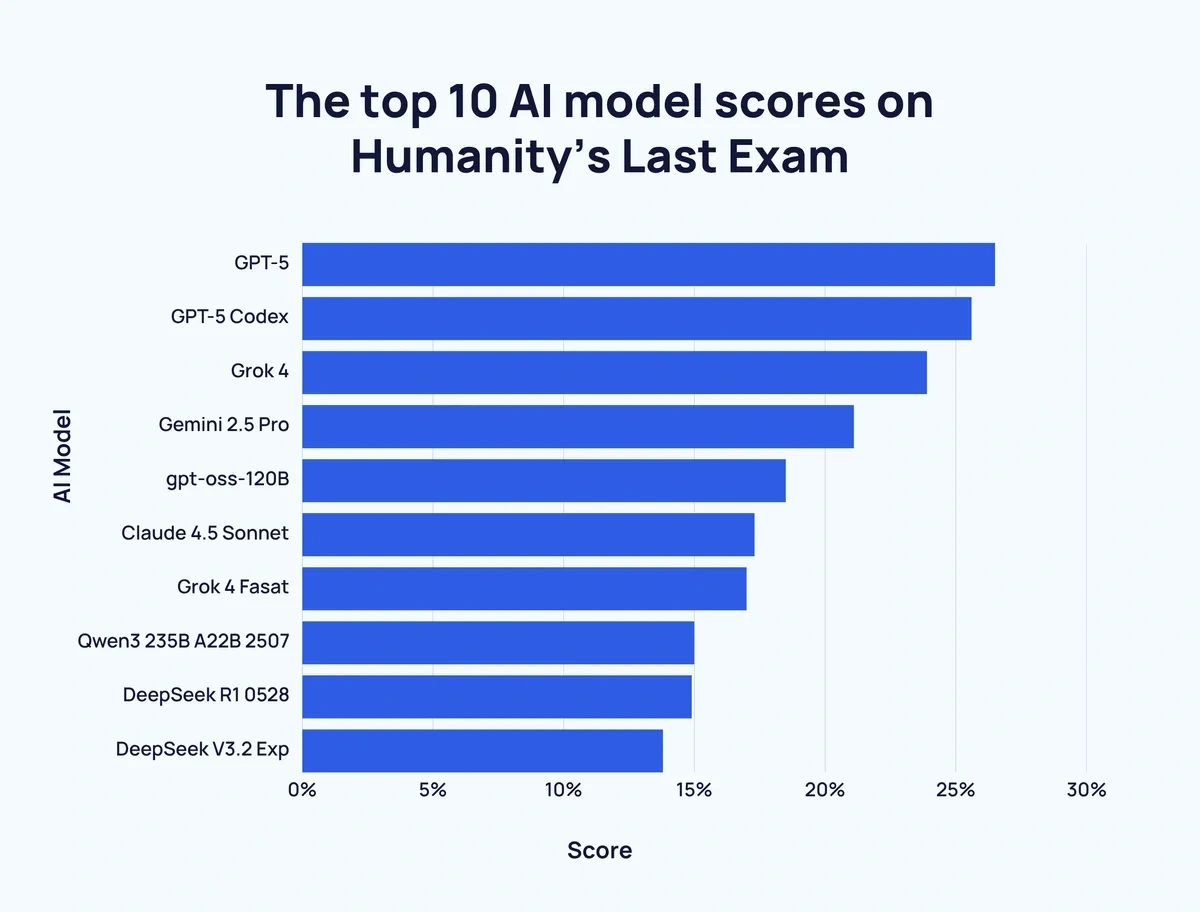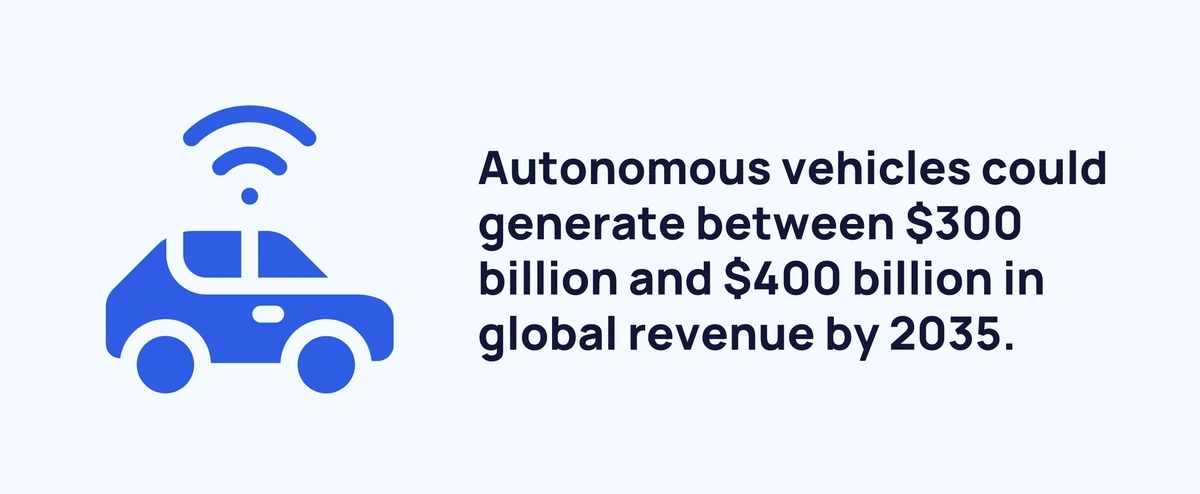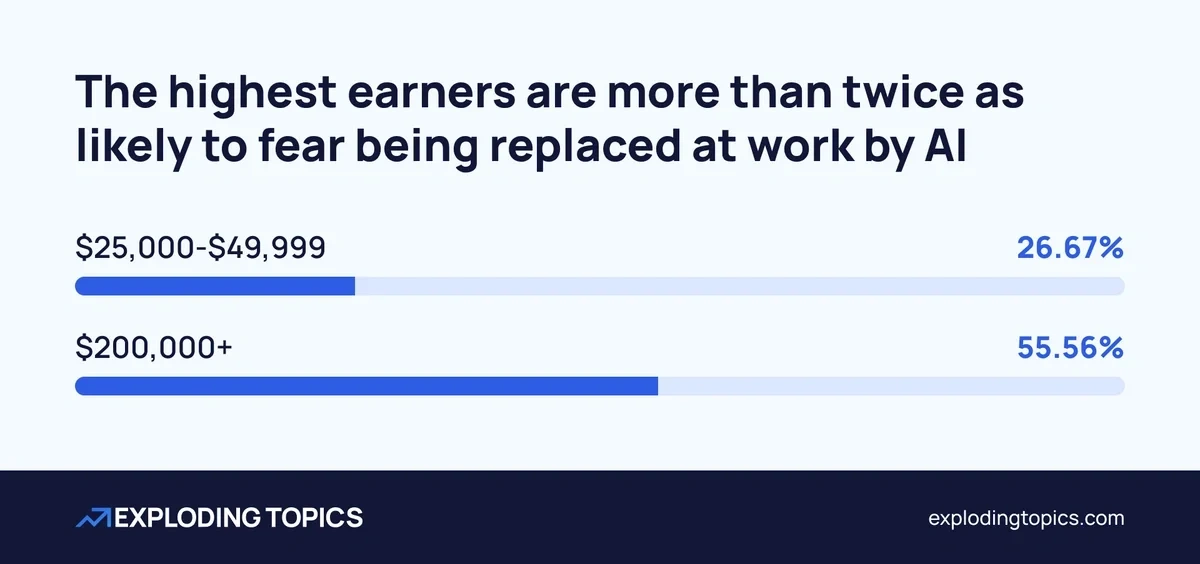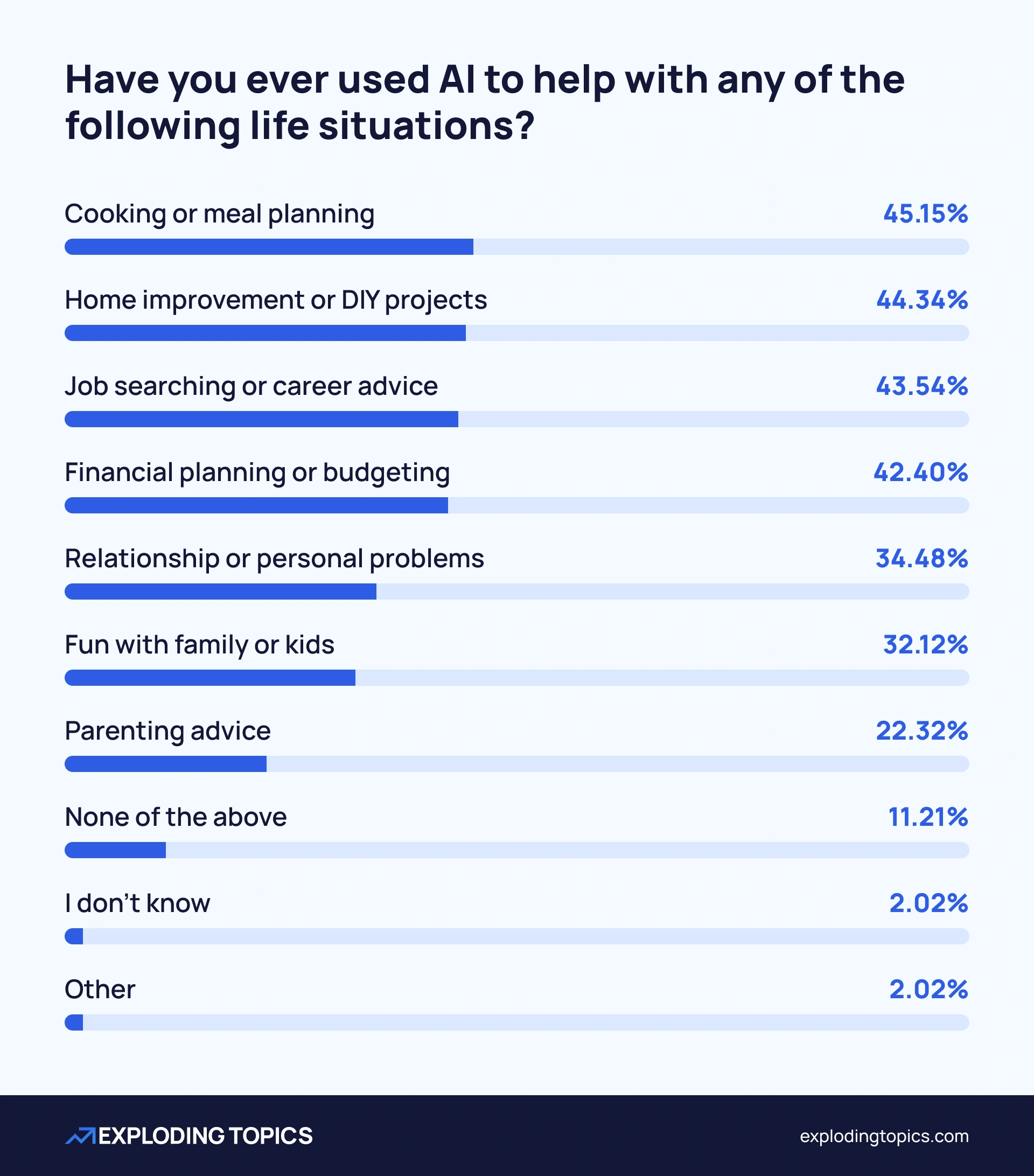
44 NEW Artificial Intelligence Statistics (October 2025)
This is a list of up-to-date artificial intelligence stats for 2025.
From ChatGPT to autonomous vehicles, AI is one of the most exciting (and controversial) technology trends in the 21st century.
But how big is the AI space? And how quickly is it growing?
In this article, we'll take a closer look at key AI statistics, along with growth projections for the future.
Top AI Statistics (Editor's Picks)
- The global AI market is valued at approximately $391 billion.
- The AI industry is projected to increase in value by around 9x by 2033.
- The AI market is expanding at a CAGR of 31.5%.
- As of 2025, 1.8% of all new job listings are specifically in the AI space.
- 90% of tech workers use AI in their jobs.
- Self-driving cars could generate revenue of $400 billion by 2035.
- AI could displace 92 million jobs by 2030 and create 170 million new roles.
- 66% of US physicians use healthcare AI.
- A fully AI-developed drug has killed resistant MRSA in lab and animal tests.
Artificial Intelligence Market Size
The AI market is worth around $391 billion (GrandViewResearch)
As of the latest available data, the global AI market is worth almost $400 billion.
This is primarily thanks to increasing practical use cases of AI technology, from content creation to self-driving cars.
The global AI market is expected to reach nearly $3.5 trillion by 2033 (GrandViewResearch)
While the current AI market is sizeable, it's set to grow by nearly 9x over the next few years, to $3.497 trillion.
During this forecast period, the AI market is predicted to increase by a CAGR of 31.5%.
The generative AI market size specifically stands at $63 billion (Statista)
Generative AI is what really catapulted artifical intelligence into the public consciousness. On its own, it is now bigger than the US video gaming industry.
ChatGPT reached 1 million users in 5 days (OpenAI)
In late 2022, ChatGPT broke records as the AI platform reached 1 million users in less than a week.
By early 2023, ChatGPT had accumulated over 100 million monthly users.
As of August 2025, OpenAI.com receives 938.3 million monthly visits. ChatGPT.com receives 5.4 billion visits, making it the #5 website globally.
Website visitors from AI search are 4.4x more valuable than visitors from organic search (Semrush)
And traffic from ChatGPT search is projected to overtake traffic from organic search in 2028.
To adjust to these emerging changes in search behavior, brands are moving to platforms such as Semrush Enterprise AIO to improve their visibility in AI search engines.
AI Adoption: Artificial Intelligence Growth
35.49% of people now use AI tools every day (Exploding Topics)
Our original research also found that 84.58% of users have increased their AI usage in the past 12 months.
78% of companies are now using AI (McKinsey)
Almost 8 in 10 organizations have now adopted at least one AI tool. Meanwhile, 90% are either already using AI or plan to introduce it in the future.
90% of tech workers are using AI tools (CNN/Google)
9 out of 10 workers in the tech industry are already using AI tools at work. That figure stood at just 14% in 2024.
Generating code is a major use case for AI in the tech sector.
The wearable AI market is expected to reach $303 billion by 2035 (Vantage Market Research)
The success of products like the Apple Watch and Fitbit is set to boost the global wearable AI market value.
Companies like Omi even claim AI companions worn on the temple will soon be able to interface with the brain.
The wearable AI market was worth $23.56 billion last year, with North America the largest market. It's forecast to clear $300 billion by 2035, at a CAGR of 17.6%.
AI tech can increase revenue by over $15 trillion by the end of the decade (PwC)
Some estimates suggest that AI technology could generate $15.7 trillion in revenue by 2030. Boosting the GDP of local economies by an additional 26%.
Worldwide investment in AI increased by more than 40% last year (Our World in Data)
The latest available data shows that $130 billion was invested into AI last year.
Worldwide private investment in AI jumped by 40.38% in 2024. Although it hasn't quite reached the heights of 2021.
This upward trajectory was forecast to continue year-over-year, increasing by at least 26% each year:
|
Year |
Private investment in AI |
|
2015 |
$15.26 billion |
|
2016 |
$19.34 billion |
|
2017 |
$28.43 billion |
|
2018 |
$46.51 billion |
|
2019 |
$61.66 billion |
|
2020 |
$77.26 billion |
|
2021 |
$145.4 billion |
|
2022 |
$104.64 billion |
|
2023 |
$92.79 billion |
|
2024 |
$130.26 billion |
Private equity has not slowed down in 2025. Between January and October, AI startups captured 51% of all venture funding, prompting fears about an AI bubble.
Worldwide AI chip revenue will surpass $92 billion this year (Statista)
The latest data shows that global AI chip revenue is set to hit $92.74 billion this year. That's a 34.58% increase.
1.8% of all jobs posted in the US are now in the AI sector (Our World in Data)
Amid fears of AI taking jobs, the technology is also creating new roles.
Almost 1 in 50 job listings in the US mention skills like natural language processing, neural networks, machine learning, or robotics.
That figure stood at just 0.7% in 2015.
Business analysts estimate that the US AI market is worth almost $47 billion (Statista)
The US AI market is worth an estimated $46.99 billion.
But it's worth noting that Statista's estimate for the size of the overall AI market is lower than the Grandview Research figure we cited earlier.
So this accounts for more than 18% of estimated global AI value, making the US the largest market.
🚀 Trending AI Startups
We’ve covered the numbers, but what about the actual companies driving the AI boom? Here are five AI startups that are trending right now, based on real-time data from the Exploding Topics engine.
How Businesses Adopt Artificial Intelligence
More than 1 in 3 organizations that use AI have adopted fully centralized AI hubs or centers of excellence (McKinsey)
Among organizations with at least one AI function, 37.6% have adopted a centralized model. This is most common in risk and compliance (57%) and data governance (46%).
Decentralized and hybrid models are more common when organizations are using AI for tech talent.
Here's a look at current company usage of AI:
| AI Use Case | Fully centralized percentage |
| Risk and compliance | 57% |
| Data governance for AI | 46% |
| AI strategy | 36% |
| Road map for AI-enhanced/AI-focused products | 35% |
| Tech talent | 29% |
| Adoption of AI solutions | 23% |
90% of UK retailers are actively exploring AI agents, with a third already implementing them (Retail Tech Innovation Hub)
AI has taken off in the retail sector. In the UK, 9 in 10 businesses are looking into AI agents.
And 61% have dedicated leadership (e.g. Chief AI Officers) in place.
63% of top-performing companies are increasing cloud budgets in order to to leverage GenAI (PwC)
Data suggests that top companies are betting big on AI, and generative AI specifically. 63% are upping cloud spend for this purpose.
Netflix's recommendations technology is worth $1 billion in revenue annually (Business Insider)
As long ago as 2016, Netflix said that its recommendation algorithm saved as much as $1 billion per year by reducing churn. The streaming platform utilizes AI to personalize recommendations and tailor them to viewers' interests.
In 2025, Netflix says it is "all in" on leveraging AI.
Data shows that Chat GPT-5 is the "smartest" AI chatbot (Artificial Analysis)
Chat GPT-5 (high) is the current high-scorer on the benchmark test known as "Humanity's Last Exam", a set of 2,500 questions across a vast array of topics.
But it still only succeeds in getting a little over a quarter of the questions correct.
| AI model | Humanity's Last Exam score |
| GPT-5 (high) |
26.5% |
| GPT-5 Codex (high) |
25.6% |
| Grok 4 |
23.9% |
| Gemini 2.5 Pro |
21.1% |
| gpt-oss-120B (high) |
18.5% |
| Claude 4.5 Sonnet |
17.3% |
| Grok 4 Fast |
17% |
| Qwen3 235B A22B 2507 |
15% |
| DeepSeek R1 0528 |
14.9% |
| DeepSeek V3.2 Exp |
13.8% |
The manufacturing industry stands to gain $3.78 trillion from AI by 2035 (Accenture)
The AI industry has a foothold in various business functions, from cloud computing for datasets to streamlining company decision-making.
Industry verticals utilizing AI technology include tech-related sales, insurance, banking, telecom, healthcare, manufacturing, retail, and marketing, to name a few.
| Industry | Baseline | Additional AI Contribution |
| Accommodation and Food Services |
$1.5 trillion |
$489 billion |
| Agriculture, Forestry, and Fishing |
$554 billion |
$215 billion |
| Arts, Entertainment, and Recreation |
$453 billion |
$87 billion |
| Construction |
$2.76 trillion |
$520 billion |
| Education |
$1.06 trillion |
$109 billion |
| Financial Services |
$3.42 trillion |
$1.15 trillion |
| Healthcare |
$2.26 trillion |
$461 billion |
| Information and Communication |
$3.72 trillion |
$951 billion |
| Manufacturing |
$8.4 trillion |
$3.78 trillion |
| Other Services |
$535 billion |
$95 billion |
| Professional Services |
$7.47 trillion |
$1.85 trillion |
| Public Services |
$3.99 trillion |
$939 billion |
| Social Services |
$1.08 trillion |
$216 billion |
| Transportation and Storage |
$2.13 trillion |
$744 billion |
| Utilities |
$962 billion |
$304 billion |
| Wholesale and Retail |
$6.18 trillion |
$2.23 trillion |
Autonomous vehicles could generate between $300 billion and $400 billion in global revenue (McKinsey)
The self-driving car market is proving to be more than a novelty niche, potentially grossing $400 billion by 2035.
88% of people have had a conversation with a chatbot in the past year (Tidio)
The prevalence of chatbots is increasing. And so is people's willingness to turn to them – 88% of people have used a chatbot at least once in the past year.
Banks can increase efficiency by 15 percentage points by embracing AI (PwC)
This will be driven by a 2x increase in customer retention rates, a 30% uplift in lead conversion, a 50% productivity boost, and 50% of staff shifting to higher-value roles as middle office tasks are automated.
Around two-thirds of medical professionals now use computer systems to aid diagnosis (American Medical Association)
66% of US physicians report using some form of healthcare AI. That's a 78% increase from 2023.
100% of industries are increasing AI usage (PwC)
Every single industry is increasing its use of AI. That includes less obviously exposed sectors like mining and agriculture.
The Zendesk CEO predicts that all customer interactions will eventually involve AI in some form (Zendesk)
Meanwhile, 59% of customers believe AI will change how they interact with companies within the next two years.
AI in Marketing, Customer Service, and Sales Statistics
Marketing and sales departments are the biggest Gen AI adopters (McKinsey)
Overall, 42% of marketing and sales departments are "regularly using" generative AI. That figure rises to 55% in the marketing and sales departments of tech companies.
Product/service development departments are the next-biggest AI adopters, at 28% overall.
Using AI in lead generation can increase conversion rates by 25% (Super AGI)
AI in lead generation can also reduce manual work by 15% or more. AI offers higher ROI and lower CAC.
51% of email marketers believe AI-supported email marketing is more effective than manual efforts (Statista)
More than half of email marketers believe AI is more effective than traditional methods. And a further 20% think AI is at least as effective as manual email marketing.
AI Replacing Jobs and Employment Statistics
Cashiers and ticket clerks are expected to lose the most jobs between now and 2030 (World Economic Forum)
Many people worry that AI will continue to take jobs from human workers, resulting in a job crisis.
And some are even asking whether they should start looking for a new career solution before automation makes their current role obsolete.
Want to Spy on Your Competition?
Explore competitors’ website traffic stats, discover growth points, and expand your market share.
Some roles are more at risk than others. The World Economic Forum projects that cashiers and ticket clerks will be at the greatest risk over the next 5 years.
Here are some of the most at-risk jobs:
| Role | Projected job loss 2025-2030 |
| Cashiers and ticket clerks | 12 million+ |
| Administrative assistants/executive secretaries | 6 million+ |
| Building caretakers, cleaners, and housekeepers | 2.5 million+ |
| Material-recording and stock-keeping clerks | 2 million+ |
| Accounting, bookkeeping and payroll clerks | 1.5 million+ |
Professional industries are not safe. Accountants and auditors are 7th on the list, with projected job losses of 500,000 or more by 2030.
Across all US industries, AI and ML in expected to replace 92 million jobs by 2030 (World Economic Forum)
Despite this, new jobs are likely to arise. The AI market will create 170 million new jobs in the same time frame, for a net job creation of 78 million.
Enterprise sign-ups to AI courses on Coursera have exceeded 200,000, as organizations look to re-skill their workforces.
Big data specialists will see the steepest job growth from 2025-2030 (World Economic Forum)
AI specialists, data warehousing specialists and autonomous vehicle specialists all feature among the 10 roles with the highest projected growth over the next five years. That's per the 2025 Future of Jobs report.
The highest earners are more than twice as likely to fear being replaced by AI at work (Exploding Topics)
Among those with a household income above $200,000, 55.56% of workers fear that AI could make their role redundant.
Where Is AI Used Today?
AI has made its way into people's homes recently via ChatGPT. But in many cases, it was already present in people's lives, albeit not as obviously.
Smart home devices are present in 72.97% of households (Statista)
Tools like smart speakers, light-switches and thermostats are present in almost three-quarters of homes worldwide.
Smart speakers use speech recognition technology to provide weather forecasts, play music, or make emergency phone calls.
AI is used in drug development to discover new treatments (BBC)
AI was involved in developing Covid-19 vaccines. And the technology has only gotten better in the intervening years.
Drugs designed "atom-by-atom" by AI have been shown to kill drug-resistant MRSA in laboratory and animal tests.
The FDA has approved over 1,200 "AI-enabled" medical devices (FDA)
The vast majority of these devices are for radiology purposes, where AI can be hugely effective in processing scans.
Some smartwatches utilize AI to provide personalized workout regimes (T3)
Wearable tech can aid the healthcare sector's mission to create a healthier world.
As well as tracking more advanced health data than ever, smartwatches use AI to offer training hints and tips, predict blood sugar variations, and provide a portable smart assistant.
Popular AI Function Statistics
Cooking and meal planning is the top "life situation" AI use case (Exploding Topics)
45.15% of AI users have turned to the technology for cooking tips. Remarkably, more than a third have also used AI for relationship/personal advice.
63% of AI users turn to the technology for research and question-answering (Exploding Topics)
Research is the top overall AI use case. More than half of users also enlist AI to create and edit text, while 23.49% use it for therapy/counselling.
There are more than 800 million weekly ChatGPT users (TechCrunch)
ChatGPT was at 400 million weekly users in February 2025. By October, that number had doubled.
The number of ChatGPT users continues to climb. Meanwhile, nearly 1.8 billion people have used some kind of AI tool.
AI Challenges & Predictions
1 in 4 Gen Zers are very concerned about AI job loss (Fortune)
Among workers aged 18-34, 24% rated their job loss concern at an 8/10 or higher. 22% are "very concerned" about losing their job to AI within the next 5 years.
Elon Musk says AI could be smarter than the sum of all human intelligence by 2030 (Times of India)
Musk believes AI could be smarter than the smartest human as early as next year. And by 2030, he believes it could exceed the combined intelligence of the entire human race.
Only 8.5% of people believe they can "always trust" AI Overviews when searching online (Exploding Topics)
Original research from Exploding Topics found significant skepticism surrounding Google's AI Overviews feature. Despite that, only 8% of people always follow links to the source material.
AI-related infrastructure will soon consume 6x more water than Denmark (UN Environment Programme)
Data center cooling is hugely water-intensive. That comes at a time where 25% of the world population lack access to clean water and sanitation.
A ChatGPT request also uses 10x the electricity of a traditional Google search.
Key Takeaways
The AI market clearly has a promising and profitable future.
While concerns over job loss exist, there is data to indicate that the technology will create more startups and jobs than it destroys.
One way or another, AI is most definitely part of the present. And the future.
For more related content, check out Top AI and Machine Learning Trends, Top AI Conferences for 2025 and 2026, and Trending Machine Learning Startups.
Stop Guessing, Start Growing 🚀
Use real-time topic data to create content that resonates and brings results.
Exploding Topics is owned by Semrush. Our mission is to provide accurate data and expert insights on emerging trends. Unless otherwise noted, this page’s content was written by either an employee or a paid contractor of Semrush Inc.
Share
Newsletter Signup
By clicking “Subscribe” you agree to Semrush Privacy Policy and consent to Semrush using your contact data for newsletter purposes
Written By


Josh is the Co-Founder and CTO of Exploding Topics. Josh has led Exploding Topics product development from the first line of co... Read more

